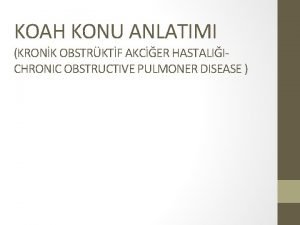2011 2 1 Natures Flyers vs Artificial Flapping

- Slides: 1

서울대학교 기계항공공학부 2011년도 2학기 기계전공대학원 세미나 1. 제 목 : Nature’s Flyers vs. Artificial Flapping Wing Vehicles 2. 연 사 : 한재흥 교수님(KAIST) 3. 일 시 : 2011년 10월 28일 (금) 16: 30 -17: 30 4. 장 소 : 301동 105호 5. 연사약력 : - 1991 : KAIST 기계공학과 학사 1993 : KAIST 항공우주공학과 석사 1998 : KAIST 항공우주공학과 박사 1998~1999 : 일본 Tohoku. Univ. 비상근강사 2000~2003 : 한국전자통신연구원, 선임연구원 2003~현 재 : KAIST 항공우주공학과 조교수, 부교수 6. 내용 : Nature's flyers have fascinated many people to study its flight mechanism for developing a machine that can aid human to fly freely in the sky just like a bird. It is well known that most of the early trials for the "flying machines" adopted flapping mechanism for generating thrust and/or lift; typical examples of the early design of flapping vehicles can be seen in the sketches of da Vinci and Cayley. After the humanities'long unquenched thirst of bird-like flight had first been realized by the powered fixed-wing flight of the Wright brothers, flapping flight, which had been giving us an inspiration of flight, seemed to be forgotten due to the great success of fixed-wing aviation. However, we now see the rebirth of flapping flying machines in much smaller scale, namely flapping-wing micro aerial vehicles (FWMAV). Equipped with a small video camera and various sensors, they can be used for surveillance and reconnaissance missions with quite perfect camouflage due to their inherent nature-like appearances. We have been witnessed that the biological flyers in nature such as birds, bats, and insects have phenomenal maneuverability and also we found that they possess highly efficient aerodynamics in a low Reynolds number regime resulting from over 150 million years of evolutionary process. The unsurpassable featuresof them have been recognized as a breakthrough of modern fixed- or rotary-wing MAVs which are having difficulties in efficiency, agility, and maneuverability. For many decades, numerous efforts have been made to mimic nature's flyers inorder to make a successful artificial micro flapping-wing vehicle. However, there exist several key technological hurdles which have not reached the level of nature's flyers. Flight muscles, joints, and body structures of nature's flyers are still far superior to the state-of-the-art micro actuators and mechanical materials. Secondary batteries such as Li-Po are not a match for biological flyers' metabolism to provide flight power. Putting aside all those technical aspects, fundamental understandings for realizing a flapping flight is also still in its infancy. The mechanism of aerodynamic force generation in a low Reynolds number regime is not fully understood yet. Also, how they sense their surroundings, how they control/guide their body attitude and trajectory is a still an ambiguous but an active research topic. Therefore, even though we have been inspired from the nature's flyers, we try to choose the best option at the current moment. For example, wing driving muscles of nature's flyers are transformed to a crank-rocker mechanism with an electric motor for an artificial flapping wing vehicle. The problem of this mechanism is that it only has few controllable degrees of freedom which mean a much underactuated system than a real bird that can control its wing freely. To compensate this for the artificial flapping wing vehicles, passive degrees of freedom from wing flexibility is considered as an alternative way to enhance the aerodynamics and controllability. A bioinspired design to make an artificial flapping wing vehicle is an important and a justifiable approach. For this, it is clear that we need more understanding in its fundamental principles such as low Reynolds number aerodynamics, flight dynamics, and flight stability. Imitating biological systems as closely as possible is perhaps a good route to reach the goal, but transferring their own functionalities to an engineering solution is also a meaningful way to develop a successful artificial flapping wing MAVs. 7. 문 의 : 기계항공공학부 이동준 교수 (djlee@snu. ac. kr) 기계항공공학부 차세대 기계항공시스템 창의설계 인력양성사업단

